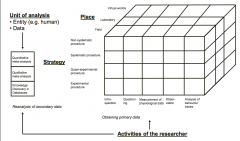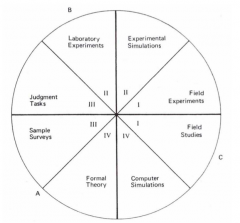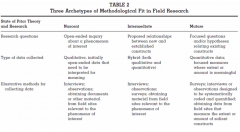![]()
![]()
![]()
Use LEFT and RIGHT arrow keys to navigate between flashcards;
Use UP and DOWN arrow keys to flip the card;
H to show hint;
A reads text to speech;
18 Cards in this Set
- Front
- Back
|
Systematization of data collection methods |

|
|
|
Choice of methods: |

|
|
|
Making choices about research methods |
–Each class of research methods comes with generic advantages and disadvantages –McGrath: only one of the three following goals can be optimized(intermediates like two ok, one bad are possible ) •Realism: the degree to which the actual phenomenon is studied (vs. lab) |
|
|
Classifying research methods: |
–Descriptive research: snapshot of the status quo –Experimental research: understanding the cause of things |
|
|
Research question, conversation, and methods |

|
|
|
Mixed-methods approaches |
–impossible to design perfect single method study –Two ways of fixing: •Multiple contributions to the conversaton •Mixed methods papers |
|
|
Sample and population |
–who you do research? |
|
|
From the population to the sample |
–who do we need to work with? (pick cases where phenomenon of ) –normally only work with subgroups |
|
|
Probability sampling: (simple) random sampling |
– Each member of the population has an equal probability of being selected – The use of random numbers applied to a list of the entire population – Purely random samples are hard to achieve, but one can come close! |
|
|
Probability sampling: Stratified sampling |
The whole population is segmented into mutually exclusive subgroups/strata, and then units are randomly selected from each stratum |
|
|
Probability sampling: Cluster sampling |
A sample is selected in two or more hierarchical stages, with different units being selected at each stage |
|
|
Non-probability sampling |
Chance of being selected of each unit is unknown or predefined |
|
|
Non-probability sampling: Convenience sampling |
–The respondents are selected, in part or in whole, at the convenience of the researcher (with no or little effort to achieve an accurate representation) –Can provide useful information, especially in a pilot study |
|
|
Non-probability sampling: Quota sampling |
–A convenience sample, with an effort made to ensure a certain distribution of demographic variables |
|
|
Non-probability sampling: Snowball(ing) sampling |
–Usually employed to access hardtoreach populations and particular subgroups in the population |
|
|
Non-probability sampling: Judgement sampling |
–The researcher uses his/her judgement in selecting the units from the population for the study –The determination is often made on the advice and with the assistance of theclient |
|
|
Non-probability sampling: Theoretical sampling (usually for qualitative work) |
–Selection of extreme case –Selection of specific/typical cases |
|
|
Threats: sampling is strongly linked to validity |
–External (Generalizability)/internal (changing input factors during the study) validity must be ensured –random error vs. systematic error |

